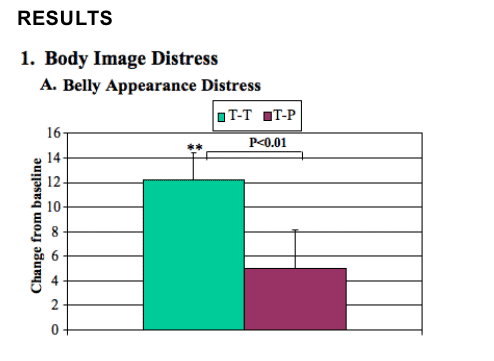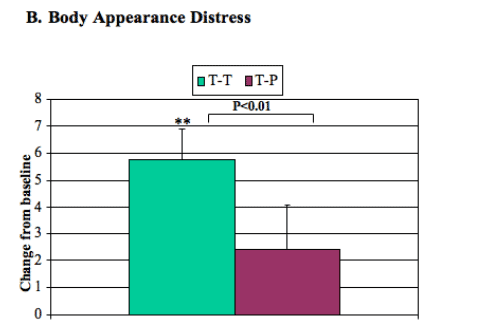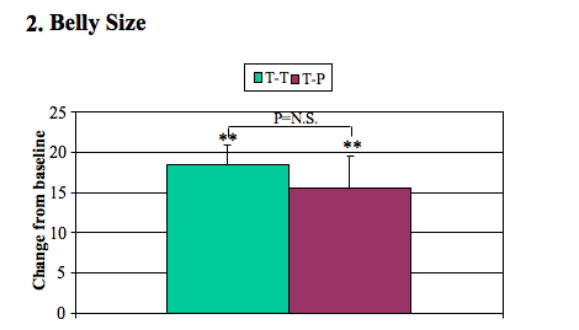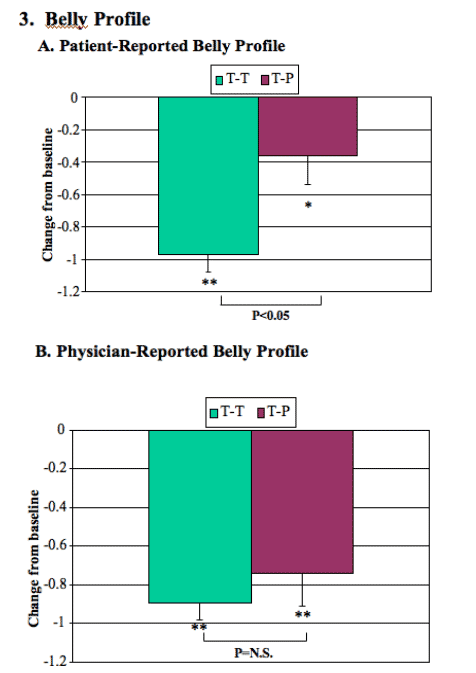 |
 |
 |
| |
Long-Term Impact of Tesamorelin (TH9507), a Growth Hormone-Releasing Factor Analogue, on Body Image Parameters in HIV-Infected Patients
with Abdominal Fat Accumulation
|
| |
| |
Reported by Jules Levin
IAC Mexico City Aug 3-8, 2008
Ralph R. Turner1, Julian Falutz2, Marcia A. Testa3, Soraya Allas4, Diane Potvin4, Jean-Claude Mamputu4, Max Su1, Steven Grinspoon5
1Phase V Technologies, Wellesley, MA, USA; 2Montreal General Hospital and McGill University Health Centre, Montreal, Canada; 3Harvard School of Public Health, Boston, MA, USA; 4Theratechnologies Inc., Montreal, Canada; 5Massachusetts General Hospital and Harvard Medical School, Boston, MA, USA
AUTHOR CONCLUSIONS
Treatment with tesamorelin 2 mg daily over 52 weeks was associated with sustained improvements in belly appearance distress and belly profile.
Improvements in body image parameters may have important implications for HIV treatment outcomes.
ABSTRACT
Background: Many HIV patients on ART show excess visceral adipose tissue (VAT) and/or loss of peripheral fat, resulting in impaired body image. Administration of 2 mg tesamorelin s.c. daily to HIV patients with lipohypertrophy for 26 weeks resulted in a significant decrease in VAT, which was sustained at Week 52 of treatment, and improvements in patient-reported outcomes. The impact of 52 weeks treatment with tesamorelin on body image parameters is reported here.
Methods: HIV patients on ART with excess abdominal fat accumulation randomized to tesamorelin 2 mg s.c. daily for 26 weeks were re-randomized to either tesamorelin 2 mg (T-T group, n=154) or placebo (T-P group, n=50) for an additional 26 weeks, while patients on placebo were switched to tesamorelin (P-T group, n=111). Body image impact outcomes, including belly and composite body appearance distress and belly profile silhouette assessments, were measured at baseline, Week 26, and Week 52 using a validated questionnaire.
Results: Study population included 315 patients (88% males) and mean age was 48 ± 7 years. Patients who continued treatment (T-T group) experienced sustained improvements in belly and body appearance distress as well as patient-reported belly profile over the 52-week treatment period (P<0.05 vs. baseline and P>0.05 for Week 52 vs. Week 26 for all parameters). On the contrary, patients who discontinued treatment (T-P group) lost improvements seen at Week 26 in belly appearance distress (P=0.05 for Week 52 vs. Week 26), body appearance distress (P=0.09 for Week 52 vs. Week 26), and patient-reported belly profile (P=0.04 for Week 52 vs. Week 26).
Conclusion: As observed with VAT, improvements in belly appearance distress and belly profile observed at Week 26 were sustained in patients treated with tesamorelin over 52 weeks. Overall, these results suggest that long-term treatment with tesamorelin has a positive effect on body image in HIV patients with lipohypertrophy.
BACKGROUND
HIV patients on antiretroviral therapy (ART) often develop excess visceral fat accumulation and metabolic abnormalities such as dyslipidemia and hyperglycemia (1-3), which may increase cardiovascular risk (4, 5, 6).
Body changes have a negative impact on patient-reported outcomes, including body image, and may thereby decrease adherence to ART (7, 8)
Treatment with tesamorelin (TH9507), a stabilized Growth Hormone-Releasing Factor (GRF)/Growth Hormone-Releasing Hormone (GHRH) analogue, for 26 weeks has been shown to result in a significant reduction in visceral adipose tissue (VAT), which was sustained at Week 52 of treatment, and improvements in patient-reported outcomes related to body image (9, 10).
MATERIALS & METHODS
Design: Patients with excess abdominal fat accumulation in the context of ART were randomized to tesamorelin 2 mg (n=273) or placebo (n=137) s.c. daily for 26 weeks. At Week 26, patients originally on tesamorelin were re-randomized to either 2 mg tesamorelin (T-T group, n=154) or placebo (T-P group, n=50) for an additional 26-week treatment period, while patients on placebo were switched to tesamorelin (P-T group, n=111). Reported here are the 52-week results.
Endpoints:
Main Primary Efficacy Endpoint:
Visceral Adipose Tissue (VAT) by computerized tomographic (CT) scan at L4-L5.
Secondary Efficacy Endpoints:
Patient-Reported Outcomes (PRO) related to body image: Belly appearance distress (main PRO parameter), belly size evaluation, patient and physician belly profile assessment using a validated questionnaire [Phase V Technologies, Inc. Outcomes Information System].
Triglycerides; Total cholesterol/HDL cholesterol ratio; IGF-1 levels.
Safety (adverse events, glucose parameters, and others).
STATISTICAL ANALYSIS
Data were analysed on intent to treat (ITT) population, with last observation carried forward (LOCF). Within-treatment comparisons were performed using Student paired t-test. Non-parametric (ranked) analysis of covariance (ANCOVA) models, with baseline and Week 26 scores, age and gender as covariates, to determine treatment differences between groups.
Parametric ANCOVA models and Mann Whitney (for patient- and physician-reported belly profile) were used as supportive analyses.
Data are expressed as mean±SEM.


Figure 1. Changes from baseline in body image distress at Week 52. Body appearance distress was scored from 0 (extremely upsetting) to 100 (extremely encouraging) with 50 indicating “not feeling either way". A positive change indicates an improvement. Baseline mean scores for belly appearance distress were 21.7 and 23.5, while baseline mean scores for body appearance distress were 35.6 and 35.9 for the T-T and T-P groups, respectively. At Week 26, tesamorelin-treated patients reported significantly less distress for belly (change from baseline: 11.6) and composite body appearance assessment (change from baseline: 5.4) than placebo. Patients treated with tesamorelin over 52 weeks experienced sustained improvements in belly appearance distress (A) and composite body appearance distress (B) (**P<0.01 vs. baseline and P>0.05 for Week 52 vs. Week 26), while patients who discontinued treatment tended to lose improvements in these parameters seen at Week 26 (P=0.05 for Week 52 vs. Week 26).

Figure 2. Changes from baseline in belly size scores at Week 52. Belly size scores were calculated as positive to 100 (larger size) and negative to -100 (smaller size) scale values, indicating a difference from « about right ». Baseline mean scores for belly size were 62.1 and 61.0 for the T-T and T-P groups, respectively. At Week 26, changes from baseline in belly size scores were -24.7 and -20.4 for the tesamorelin and placebo groups, respectively (**P<0.001 vs. baseline for both groups, and P>0.05 for tesamorelin vs. placebo). At Week 52, change scores were expressed as the negative value of (absolute (LOCF)-absolute (baseline), which would yield positive scores for subjects moving towards improvement. Improvements in belly size observed in both groups at Week 26 were sustained at Week 52 of treatment (P<0.001 vs. baseline and P>0.05 for Week 52 vs. Week 26).

Figure 3. Changes from baseline in belly profile at Week 52. Belly profiles were scaled from 0 (Normal) to 5 (Largest belly). Baseline mean scores for patient-reported belly profile were 3.4 and 3.2, while baseline mean scores for physician-reported belly profile were 3.1 and 3.1 for the T-T and T-P groups, respectively. At Week 26, patient-reported belly profile (change from baseline: -0.7) and physician-reported belly profile (change from baseline: -0.6) improved more in tesamorelin-treated patients vs. placebo. Patients who received tesamorelin over 52 weeks (T-T Group) experienced sustained improvements in self-reported belly profile (A) (**P<0.01 vs. baseline and P>0.05 for Week 52 vs. Week 26), while patients who discontinued treatment (T-P group) did not sustain improvements seen at Week 26 in self-reported belly profile (*P<0.05 vs. baseline and P=0.04 for Week 52 vs. Week 26). Physician-reported belly profile improved significantly from baseline to Week 52 in both groups. No between-group differences were observed.
References.
1. Grinspoon and Carr. N Engl J Med 2005;352(1):48-62.
2. Behrens et al. AIDS;13:F63-F70..
3. Friis-Moller et al. N Engl J Med 2003;349(21):1993-2003.
4. Schmidt et al. Antiv Ther 1999;4(3):163-170.
5. Hadigan et al. Clin Infect Dis 2001;32(1):130-139.
6. Wohl et al. 15th Conference on Retroviruses and Opportunistic Infections, Boston, MA, February 2008 (Abstract # 956).
7. Ging et al. Qual Life Res 2000;9:55-63.
8. Duran et al. AIDS 2001;14:2441-2444.
9. Falutz et al. N Engl J Med. 2007;357:2359-70.
10. Turner et al. 9th International Workshop on Adverse drug Reactions and Lipodystrophy in HIV, Sydney, Australia, July 2007.
|
| |
|
 |
 |
|
|